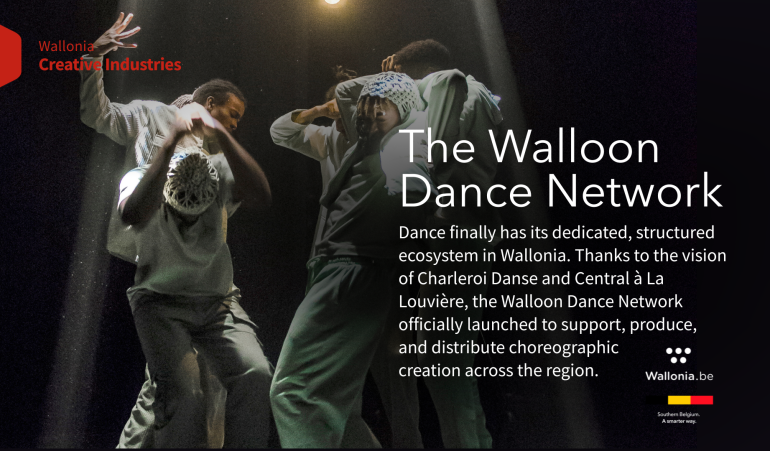
Charleroi Danse and Central à La Louvière had a dream. And today, it’s here!
Dance has found its place in Wallonia: the Walloon Dance Network. We owe this initiative to Fabienne Aucant and Vincent Thirion, respectively director of Charleroi Danse and director of Central à La Louvière, for bringing together seven cultural centres and six performing arts centres.
The goal? To better produce and disseminate choreographic creation across Wallonia and support major productions.
How it came to be
In 2020, a smaller, more informal, network already existed. Thanks to the incentive of Vincent Thirion shortly after his arrival as the head of Central à La Louvière, it was formalised and expanded, with the participation of the Performing Centres, and the support of Charleroi Danse.
Fabienne Aucant
"When I arrived at La Louvière in 2017, Thirion (former director of Charleroi dance) said amused: ’you are going to build a second choreographic centre here'." This would not be the case. “But I still wanted to promote dance as an art form which involves other disciplines. And to create a system for its dissemination across Walloon cultural centres, which are often reluctant to programme it since it’s 'not made for their audiences'.”
The lack of suitable mediation was a first barrier to the Walloon dissemination. "Another barrier,” again emphasizes Vincent Thirion, “is that of the technical capabilities of the receiving structures are sometimes unsuitable". An observation that he and Fabienne Aucant made during their tour of the partner cultural centres in 2022. This tour allowed them to set up the technical sheets of the shows they planned to shoot and provide further technical support.
Vincent Thirion
This observation (cold reception/technical gaps) partly explains the conclusions made by the ‘Etat des lieux’ on the dissemination of dance in the Fédération Wallonie-Bruxelles of the RAC (April 2025): « ... we are facing a deficit in the dissemination of dance in FWB (...). A newly created dance show is rarely performed more than a few times: on average 3 to 4 performances in Brussels, 1 to 2 in Charleroi. This low programming rate strongly limits the meeting between the works and the audience. And this, despite an "artistic vitality, talent, a great potential for international distribution, a current development of choreographic practices and an audience in increase”. »
The same report highlights the imbalance between Wallonia and Brussels and the centralisation of the choreographic offer in the Capital, explained « by specific support such as the COCOF Network of Choreographic Scenes (9 places supported annually for 15 years) without an equivalent in Wallonia. »
Fabienne Aucant confirms: "Dance is in second to last position for financial support, just above children’s stories!". Also confirmed by the director of Charleroi Danse: "This creative and research dynamic is particularly strong at the languages level. Dance opens up to young audiences, to urban expressions, and is interested in the various developments of our time, including digital technology.” It was therefore necessary to finally give it the (Walloon) visibility it deserves.
Then, act!
Similar observations, similar desires. It was enough for the two structures to unite their strengths, finances and personnels. "It was necessary to be an interventionist,” says Fabienne Aucant when she talks about the creation of the Walloon Dance Network. Even if she understands "the high level of time it will take to make things happen".
The first component of the network’s work is to consolidate and develop it. And Fabienne Aucant notes: it is necessary to make dance known, through mediation, at all levels (programmers, spectators, communicators...). The second part concerns the size of the shows. The director mentions an investigation by Contredanse, a resource centre, publishing and documentation in dance in FWB. This survey says that the number of people on stage for projects supported by the Wallonia-Brussels Federation went from an average of 3.5 to 2.5 between 2000 and 2024. "But the bigger projects, with more than 6 performers on stage, are bringing larger audiences," points out Fabienne Aucant.
This is the dual objective of the network: to create 'great' shows and boost their distribution.
Across these two axes, the first is around the six partner Performing Centres (out of the nine present across FWB) which have committed to producing and broadcasting a show every two years with at least 6 performers on stage.
"The first project chosen,” continues the director, “will be Irrésistible Révolution by Ayelen Parolin. 12 performers on stage! It will premiere in April 2026 at the National, before touring in the network’s centres.”
The second axis is around the Cultural Centres. Concretely? A steering committee has been formed, made up of experienced people in the field of dance. This committee has selected 10 shows, offered to all the Cultural Centres (proposed, not imposed: "we never forced anyone," has emphasized, laughing, Vincent Thirion) for programming. And this is also where Charleroi Danse and Central intervene very concretely, committing to co-presenting the shows with these cultural reception centres.
For this, Charleroi and La Louvière are currently operating on their own funds, ‘50-50’. That is 50% at the expense of the Cultural Centre hosting and 50% for Charleroi and La Louvière, with financial and personnel support. This allows the Cultural Centres to reduce costs and have a return to their budget despite a certain risk-taking.
And tomorrow...
This support nevertheless remains a weight for the two structures. "We obviously have the Minister’s ears,” continues Aucant, “but we are looking for lasting support. Support that we can shape. There is a real challenge to find the means to develop this network.” A position the director wants in discussion and exchange. "All it takes is to create a spark," she sums up.
BLIND-42 by Shino Vision
Then Fabienne Aucant says further. "If initially we separate the two axes, dissemination and creation in large formats, for organizational reasons, we have in mind the objective of spring 2027." The organization of a great unifying spring dance, with all the network participants.
And Fabienne Aucant concluded: "I watched the 2021 figures, live post-Covid. They prove that dance is exported very well internationally. We were at 181 performances in 2021, compared to 209 for theatre. Almost equal. Except that the means for dance creation are three times smaller. If we compare, there are fewer companies, fewer projects in creation, but as much in terms of distribution as the theatre. We would like this international influence to have a counterpart in Wallonia.” Because, as Vincent Thirion finally points out: "Dance is everyone’s business. As Thierry De Mey said, it is the most unifying discipline. So let’s unite and dance, now!”
The partners of the Walloon Dance Network
The 7 Cultural Centers:
• CC d’Engis Centre culturel d'Engis
• CC de Rixensart CENTRE CULTUREL DE RIXENSART
• CC du Brabant wallon Centre culturel du Brabant wallon
• La Maison de la Culture de Marche-en-Famenne
The 6 Scenic Centers:
• Mars- Mons arts de la scene Mars - Mons arts de la scène
• Le Théâtre National Wallonie-Bruxelles
• Le Théâtre Jean Vilar de Louvain-la-Neuve
• Charleroi danse Charleroi danse
By Isabelle Plumhans for W+B n' 169
Linked articles
Related articles

A World of Opportunities: How International Mobility Shapes Tomorrow’s Professionals

Warmer People x Dour in London 2025: Showcasing Belgian Sound Abroad

A Historic Milestone at Hougoumont Farm: the Landmark Launch at Waterloo







